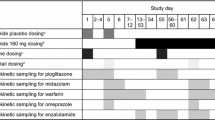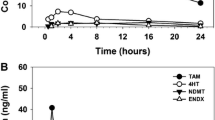Abstract
Purpose
Tamoxifen and ondansetron were commonly metabolized via rat hepatic CYP2D subfamily and 3A1/2, and ondansetron is used to treat chemotherapy-induced nausea. The purpose of this study was to report the pharmacokinetic interaction between tamoxifen and ondansetron in rats.
Methods
The pharmacokinetics of tamoxifen and ondansetron were evaluated after the intravenous and oral administration of tamoxifen, ondansetron, and both drugs together to rats. The V max (maximum velocity), K m (apparent Michaelis–Menten constant), CLint (intrinsic clearance), K i (inhibition constant), and [I] (concentration of inhibitor in the liver and intestine)/K i ratio of ondansetron were also measured.
Results
The AUC0–∞s of tamoxifen were significantly greater after both intravenous and oral administration with ondansetron compared to those of tamoxifen alone. The significantly slower hepatic and intestinal CLints for the disappearance of tamoxifen with both drugs together were due to inhibition of metabolism of tamoxifen by ondansetron via CYP2D subfamily and 3A1/2.
Conclusions
The significantly greater AUC0–∞ of tamoxifen after the intravenous administration of both drugs together could have possibly been attributable to a non-competitive (hepatic) inhibition of CYP2D subfamily- and 3A1/2-mediated tamoxifen metabolism by ondansetron. The significantly greater AUC0–∞ of tamoxifen after the oral administration of both drugs together could have been attributable to a competitive (intestinal) inhibition of CYP2D subfamily- and 3A1/2-mediated tamoxifen metabolism by ondansetron in addition to non-competitive inhibition in the liver.



Similar content being viewed by others
Abbreviations
- Ae 0–24h :
-
Percentage of the dose excreted in the 24-h urine
- AUC0–∞ :
-
Total area under the plasma concentration–time curve from time zero to time infinity
- C max :
-
Peak plasma concentration
- CL:
-
Time-averaged total body clearance
- CLR :
-
Time-averaged renal clearance
- CLNR :
-
Time-averaged non-renal clearance
- CLint :
-
Intrinsic clearance
- CYP:
-
Cytochrome P450
- F :
-
Extent of absolute oral bioavailability
- FMO:
-
Flavin-containing monooxygenase
- GI24h :
-
Percentage of the dose recovered from the gastrointestinal tract (including its contents and feces) at 24 h
- HPLC:
-
High-performance liquid chromatography
- I:
-
Inhibitor
- K i :
-
Inhibition constant
- K m :
-
Apparent Michaelis–Menten constant
- T max :
-
Time to reach C max
- V max :
-
Maximum velocity
- V ss :
-
Apparent volume of distribution at steady state
References
Jordan VC (1988) The development of tamoxifen for breast cancer therapy: a tribute to the late Arthur L. Walpole. Breast Cancer Res Treat 11:197–209
Thummel KE, Shen DD, Isoherranen N, Smith HE (2006) Appendices II: design and optimization of dosage regimens; pharmacokinetic data. In: Brunton LL, Lazo JS, Parker KL (eds) Goodman and Gilman’s The pharmacological basis of therapeutics, 11th edn. McGraw-Hill, New York, pp 1856–1875
Jacolot F, Simon I, Dreano Y, Beaune P, Riche C, Berthou F (1991) Identification of the cytochrome P450 IIIA family as the enzymes involved in the N-demethylation of tamoxifen in human liver microsomes. Biochem Pharmacol 41:1911–1919
Crewe HK, Ellis SW, Lennard MS, Tucker GT (1997) Variable contribution of cytochromes P450 2D6, 2C9 and 3A4 to the 4-hydroxylation of tamoxifen by human liver microsomes. Biochem Pharmacol 53:171–178
Mani C, Gelboin HV, Park SS, Pearce R, Parkinson A, Kupfer D (1993) Metabolism of the antimammary cancer antiestrogenic agent tamoxifen. I. Cytochrome P-450-catalyzed N-demethylation and 4-hydroxylation. Drug Metab Dispos 21:645–656
Gamboa da Costa G, Marques MM, Fu X, Churchwell MI, Wang YP, Doerge DR, Beland FA (2007) Effect of N,N-didesmethyltamoxifen upon DNA adduct formation by tamoxifen and alpha-hydroxytamoxifen. Cancer Lett 257:191–198
Yang SH, Lee MG (2008) Effects of CYP inducers and inhibitors on the ondansetron pharmacokinetics in rats: involvement of CYP2D subfamily and 3A1/2 for the ondansetron metabolism. J Pharm Pharmacol 60:853–861
Yang SH, Lee MG (2008) Dose-independent pharmacokinetics of ondansetron after intravenous and oral administration to rats: contribution of hepatic and intestinal first-pass effects to low bioavailability. Biopharm Drug Dispos 29:414–426
Gilbert CJ, Petros WP, Vredenburgh J, Hussein A, Ross M, Rubin P, Fehdrau R, Cavanaugh C, Berry D, McKinstry C, Peters WP (1998) Pharmacokinetic interaction between ondansetron and cyclophosphamide during high-dose chemotherapy for breast cancer. Cancer Chemother Pharmacol 42:497–503
Cagnoni PJ, Matthes S, Day TC, Bearman SI, Shpall EJ, Jones RB (1999) Modification of the pharmacokinetics of high-dose cyclophosphamide and cisplatin by antiemetics. Bone Marrow Transpl 24:1–4
Oh EY, Bae SK, Kwon JW, You M, Lee DC, Lee MG (2007) Pharmacokinetic and pharmacodynamic consequences of inhibition of terazosin metabolism via CYP3A1 and/or 3A2 by ondansetron, an erectogenic, in rats. Br J Pharmacol 151:24–34
Lee JH, Lee MG (2008) Telithromycin pharmacokinetics in rat model of diabetes mellitus induced by alloxan or streptozotocin. Pharmacol Res 25:1915–1924
Bradford MM (1976) A rapid and sensitive method for the quantification of microgram quantities of protein utilizing the principle of protein–dye binding. Anal Biochem 72:248–254
Duggleby RG (1995) Analysis of enzyme progress curves by nonlinear regression. Methods Enzymol 249:61–90
Choi YH, Chung SJ, Lee MG (2008) Pharmacokinetic interaction between DA-8159, a new erectogenic, and metformin in rats: competitive inhibition of metabolism via hepatic CYP3A1/2. Br J Pharmacol 153:1568–1578
Huskey SW, Dean DC, Miller RR, Rasmusson GH, Chiu SH (1995) Identification of human cytochrome P450 isozymes responsible for the in vitro oxidative metabolism of finasteride. Drug Metab Dispos 23:1126–1135
Kim SH, Choi YM, Lee MG (1993) Pharmacokinetics and pharmacodynamics of furosemide in protein-calorie malnutrition. J Pharmacokinet Biopharm 21:1–17
Murakami T, Nakanishi M, Yoshimori T, Okamura N, Norikura R, Mizojiri K (2003) Separate assessment of intestinal and hepatic first-pass effects using a rat model with double cannulation of the portal and jugular veins. Drug Metab Pharmacokinet 18:252–260
Depot M, Leroux S, Caille G (1997) High-resolution liquid chromatographic method using ultraviolet detection for determination of ondansetron in human plasma. J Chromatogr B Biomed Sci Appl 693:399–406
Bauer S, Stormer E, Kaiser R, Tremblay PB, Brockmoller J, Roots I (2002) Simultaneous determination of ondansetron and tropisetron in human plasma using HPLC with UV detection. Biomed Chromatogr 16:187–190
Webster LK, Crinis NA, Stokes KH, Bishop JF (1991) High-performance liquid chromatographic method for the determination of toremifene and its major human metabolites. J Chromatogr 565:482–487
Lim CK, Chow LC, Yuan ZX, Smith LL (1993) High performance liquid chromatography of tamoxifen and metabolites in plasma and tissues. Biomed Chromatogr 7:311–314
Gibaldi M, Perrier D (1982) Pharmacokinetics, 2nd edn. Marcel-Dekker, New York
Chiou WL (1978) Critical evaluation of potential error in pharmacokinetic studies using the linear trapezoidal rule method for the calculation of the area under the plasma level–time curve. J Pharmacokinet Biopharm 6:539–546
Lineweaver H, Burk D (1934) The determination of enzyme dissociation constants. J Am Chem Soc 56:658–666
Dixon M (1953) The determination of enzyme inhibitor constants. Biochem J 55:170–171
Shin SC, Choi JS, Li X (2006) Enhanced bioavailability of tamoxifen after oral administration of tamoxifen with quercetin in rats. Int J Pharm 313:144–149
Bachmann KA, Lewis JD (2005) Predicting inhibitory drug–drug interactions and evaluating drug interaction reports using inhibition constants. Ann Pharmacother 39:1064–1072
Aiba T, Takehara Y, Okuno M, Hashimoto Y (2003) Poor correlation between intestinal and hepatic metabolic rates of CYP3A4 substrates in rats. Pharm Res 20:745–748
Dixon CM, Colthup PV, Serabjit-Singh CJ, Kerr BM, Boehlert CC, Park GR, Tarbit MH (1995) Multiple forms of cytochrome P450 are involved in the metabolism of ondansetron in humans. Drug Metab Dispos 23:1225–1230
Fischer V, Vickers AE, Heitz F, Mahadevan S, Baldeck JP, Minery P, Tynes R (1994) The polymorphic cytochrome P-4502D6 is involved in the metabolism of both 5-hydroxytryptamine antagonists, tropisetron and ondansetron. Drug Metab Dispos 22:269–274
Lewis DFV (1996) P450 substrate, specificity and metabolism. In: Cytochrome P450. Structure, Function and metabolism. Taylor and Francis, Bristol, PA, p 123
Acknowledgment
This study was supported in part by 2008 BK21 Project for Applied Pharmaceutical Life Sciences.
Author information
Authors and Affiliations
Corresponding author
Rights and permissions
About this article
Cite this article
Yang, S.H., Suh, J.H. & Lee, M.G. Pharmacokinetic interaction between tamoxifen and ondansetron in rats: non-competitive (hepatic) and competitive (intestinal) inhibition of tamoxifen metabolism by ondansetron via CYP2D subfamily and 3A1/2. Cancer Chemother Pharmacol 65, 407–418 (2010). https://doi.org/10.1007/s00280-009-1043-4
Received:
Accepted:
Published:
Issue Date:
DOI: https://doi.org/10.1007/s00280-009-1043-4




